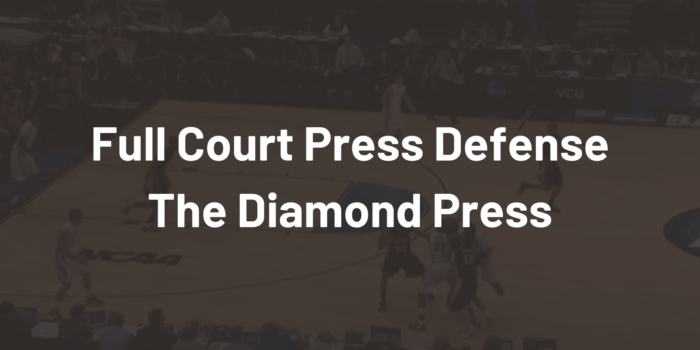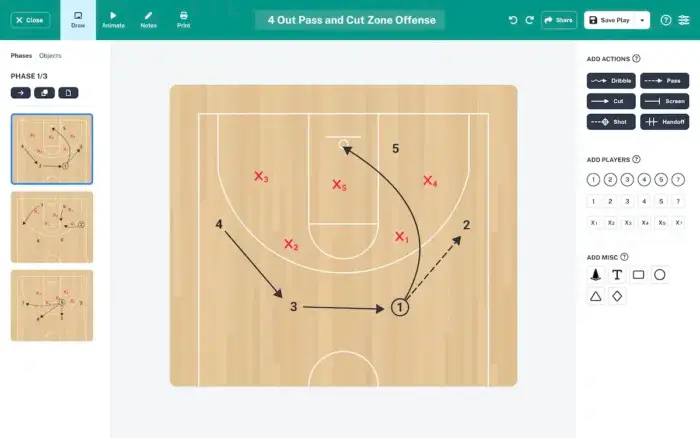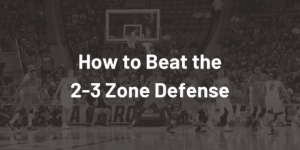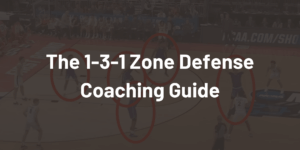Full court pressure defense is one of the most exciting strategies in basketball. When executed properly, it can completely change the pace of the game, frustrate opponents, and create easy scoring opportunities. However, many coaches shy away from full court pressure because they view it as too risky or demanding on their players.
Why We Picked the Diamond Press
The diamond press is more than just a defensive strategy—it's a game-changing system that allows teams to control tempo, create chaos, and convert defensive pressure into easy scoring opportunities.
When properly implemented, the diamond press can be one of the most effective weapons in your defensive arsenal. It's not just about forcing turnovers – it's about controlling the game's rhythm, wearing down opponents mentally, and creating the type of defensive identity that defines championship programs.
Advantages Over Other Full Court Press Defenses
The diamond press stands out from other pressure defenses in several key ways:
- More structure than run-and-jump press while still getting you a lot of turnovers
- Better court coverage than traditional 2-2-1 press, making it harder to break
- Creates multiple defensive layers that prevent clean passing lanes
- Highly adaptable - can be run as aggressive turnover-generating defense or dialed back to a containment press
- Psychological impact - even experienced guards get rattled facing persistent trapping
- Proven results - teams implementing this system see an average increase of 25% in backcourt turnovers
Last season, we faced a team whose point guard was averaging just two turnovers per game – he committed seven in the first half alone against our diamond press!
Understanding The Diamond Full Court Press
The Diamond Press Formation
The diamond press positions four defenders in a diamond shape with a fifth playing safety. This formation creates natural pressure points across the court, making it difficult for opponents to advance the ball efficiently.
Fundamental Principles
For the diamond press to work effectively, your team must commit to these core principles:
1. No Sideline Dribbling
Force offensive players toward the sideline to create trapping opportunities, but prevent them from dribbling past your wing defender. The key is for the wing defender to cut off forward progress while the trapping defender arrives. If an offensive player manages to dribble parallel or past your wing, they've broken a crucial element of the press.
2. No Passes to the Middle
Middle passes collapse your defensive pressure by giving offenses a full view of both sides of the court. Your defenders must influence passes toward the sidelines while actively denying middle passing lanes through good positioning and anticipation.
3. No Fouling on Traps
Patient trapping defense creates turnovers through positioning, not reaching. Focus on keeping high hands and forcing the offense to attempt difficult passes over or around your defense. This disciplined approach wears down offenses while avoiding foul trouble.
Personnel and Roles
The foundation of the diamond press begins with proper positioning and understanding each role:
Disruptor (X4): Your tallest defender who pressures the inbounder. This player needs good length and the ability to disrupt vision while quickly transitioning to trap after the inbound pass. The disruptor's job is to force difficult inbound passes and then quickly help create the first trap.
Wing Defenders (X1 and X2): Quick, lengthy players positioned on each side of the court. They deny direct passes up the sideline and help create the first trap when the ball is inbounded. Wing defenders must have good lateral quickness and the discipline to maintain proper positioning without gambling.
Interceptor (X3): Smart defender positioned between the three-point line and half court. This player reads the offense and anticipates passes while denying middle penetration. The interceptor needs excellent basketball IQ and the ability to make quick decisions in rotation.
Safety (X5): Your best help defender protecting against long passes near half court. The safety is the last line of defense and prevents easy scores if the press is broken. This player must be reliable, communicate well, and have good anticipation skills.
How to Execute the Diamond Press
1. During the Inbound
The disruptor (X4) applies pressure on the inbounder, using their height and length to make the inbound pass difficult. Wings (X1 and X2) position themselves to deny direct passes up the sidelines, while slightly favoring the corners to bait passes there. The interceptor (X3) denies any middle options, and the safety (X5) protects against deep passes.
2. Initial Trap
When the ball is inbounded to the corner or sideline, that's your cue to trap. Two defenders (typically the disruptor and the nearest wing) create a trap against the sideline or baseline.
Trap Fundamentals:
- Trap with body position, not hands
- Keep hands high to block vision
- Force the ball toward the baseline/sideline
- Make sure there are no gaps between defenders
- Communicate constantly between defenders
We teach our players two trapping options:
- Immediate Trap: The disruptor immediately sprints to trap with the wing defender as soon as the ball is inbounded. This is our base defense and works well with younger teams.
- Delayed Trap: An advanced variation where the disruptor stays denying the pass back to the inbounder until the receiver's first dribble, then sprints to create the trap. This requires excellent timing but can be more effective against experienced guards.
3. Pass Back to the Inbounder
If the offensive player passes back to the inbounder, the entire defense rotates to maintain pressure. The disruptor now defends the new ball handler, while other defenders shift to maintain the diamond shape. The goal is to force another sideline pass for another trap opportunity.
4. Pass Over the Top
If the offense breaks the initial trap with a pass over the top, the interceptor becomes crucial. They should slow down the offensive player while the rest of the team sprints back to prevent an easy score. The safety now becomes the primary defender against fast breaks.
5. The Press Breaks - Transitioning to Set Defense
When the press breaks, every player must sprint back without exception. The defender closest to the ball works to slow the offense without fouling, while back defenders protect against easy scores. Proper communication during retreat ensures matched transitions and can even create additional turnover opportunities through back-tips and defensive reads.
Even when teams break your initial pressure, the press often accomplishes its secondary goal - forcing an accelerated offensive tempo that can lead to rushed shots and forced passes in the half court.
Common Mistakes to Avoid
Watch out for these common execution errors:
- Loss of defensive base: Defenders cross their feet instead of maintaining a strong, balanced stance with proper shuffling footwork
- Overaggressive trapping: Standing too tall or leaning over offensive players instead of staying low with bent knees
- Improper trap spacing: Leaving too much room between defenders or clustering too tightly
- Late defensive rotation: Moving after the ball arrives rather than anticipating passes
- Watching the ball: Help defenders fixate on the ball instead of seeing both the ball and their area
- Reaching in traps: Gambling for steals instead of focusing on solid positioning
How to Teach the Diamond Full Court Press
Implementation Strategy
Proper implementation requires at least three weeks of fundamental work before using the press in games. Here's how to build up to it:
- Basic Positioning: Use cones to help players know where they need to be
- Basic Rotations: Practice movement patterns without offense, focusing on communication
- Trapping Concepts: Gradually introduce trapping fundamentals
- Live Opposition: Progress to working against real offensive players
Progressive Skill Development
Start by breaking down each position into small-sided drills:
- 1-on-2 Trap Development: Focus on the initial trap mechanics between the disruptor and wing defender
- 2-on-3 Middle Denial: Build on the initial trap while introducing the interceptor's role
Then expand to full-court implementation through these progressions:
- 3-on-4 Practice: Replace the coach with a live inbounder and utilize both sides of the court
- 4-on-4 Execution: Add a fourth offensive player to develop complete rotation patterns
- 5-on-5 Integration: Implement the complete system with all positions
1-2-1-1 Diamond Press Drills
After mastering 5-on-5 execution, challenge your defense with this 6-on-4 half-court drill. This overload situation forces defenders to perfect their rotations and communication while operating at a disadvantage. The extra offensive player creates natural stress points in your defense, revealing any weaknesses in positioning or help coverage.
- Setup: 6 offensive players vs 4 defenders in half court (we leave out the safety position)
- Duration: 12-15 minutes
- Focus: Rotation speed, communication, and help defense
- Instructions: The offense starts with an inbound pass from the baseline, aiming to advance the ball against the press. Defenders create the initial trap and then rotate to cover passing lanes. We typically run this for 3-4 passes before resetting.
- Restrictions: The offense must start by inbounding to the corners or sidelines to practice our trap situations
- Goals: Defense aims to force turnovers or disrupt offensive flow; offense works on breaking the press
- Key teaching point: Defenders must anticipate rather than react to offensive movement
This 4 v 4 drill works on pushing the ball up the court on offense as well as communication and rotation on defense with the disadvantage. This drill will help your team to become better at minimizing the damage from when a full court press gets broken and you need to slow down then offense defending 3 vs 4.
The drill starts with 4 defensive players lined up across the free throw line extended and 4 offensive players lined up on the baseline straight across from them.
The coach will start the drill by passing the ball to a random offensive player.
On the pass, the defender that is matched up with the ball must touch the baseline before getting back on defense.
The other 3 defenders must get back, stop ball and match up in help until their 4th defender gets back into the play.
Offensively, work on spacing and sprinting the lanes. Ideally pushing the ball up the middle of the court.
Remember, passing the ball up the court is faster than dribbling and will take more advantage of the mismatch.
If defense is able to stop the transition offense, they continue playing 4v4 until a score or stop.
The drill starts over on this side of the court, switching offense and defense heading the other direction.
Building Program Success
Team Buy-In
Success requires explaining the pressure philosophy and its benefits to players. Help them understand why we press and how it helps us win games. Integrate press-specific conditioning into regular practice routines to build the stamina needed for sustained execution.
Regular film study sessions allow teams to learn from both successes and breakdowns. Show players both the good and bad examples so they can see the difference in execution.
Advanced Concepts & In-Game Adjustments
Free Throw Press Implementation
The diamond press particularly excels after free throws, creating immediate pressure through quick transitions:
- The free throw shooter becomes the front defender
- Lane players retreat to wing positions
- Remaining players fill the diamond and safety spots
This creates instant pressure before the offense can set up their press break.
One of the best times to run a diamond press is out of a made free throw. This drill will help you simulate that in practice.
Note:
We're going to show player 4 making a free throw, but during practice if it's a missed free throw, players 1, 2 and 4 will rotate until a free throw is made.
The drill starts with a free throw situation.
On a made shot, the offense takes the ball out of bounce and the defense sets up in their diamond press.
The diamond press works so well out of a free throw situation because the back two defenders are already set up and the front of the diamond is a quick transition from the free throw lineup.
The shooter becomes the front of the diamond and the two players on the blocks pop out to the wings.
Here we see the defense has quickly setup in the press and the offense is taking the ball out of bounds to set up their press breaker.
If the ball goes to the corner, it's an immediate trap while the other wing and interceptor get into passing lanes.
On a flash to middle, the wing would cover this because we want to avoid any middle passes and we're okay with the sideways pass to 3 because we still have time to rotate and trap again.
Once offense has crossed half court the drill stops and resets on the other end, switching offense and defense.
Neutralizing Dominant Guards
When facing teams with a primary ball handler who's hard to stop:
- Commit two defenders to deny their best guard
- Force secondary handlers to break pressure
- Make their star player work harder to get the ball
- Disrupt their offensive rhythm and lead to rushed possessions
When to Adjust or Stop the Press
Learn to recognize when to adjust or pull back from the press:
- Consistent middle penetration
- Regular success against your first trap
- Multiple easy baskets given up
- Key defenders in foul trouble
- Team showing fatigue
Adjustment Options:
- Reduce trap aggression while maintaining formation
- Switch to containment press focusing on tempo control
- Pull back to halfcourt defense temporarily
- Rotate fresh defenders into key pressure positions
Conclusion
The diamond press isn't just another defensive set – it's an aggressive mindset that can define your team's identity. When properly executed, it creates the type of organized chaos that most teams simply aren't prepared to handle.
Success comes from thorough preparation, clear communication, and understanding both the strengths and limitations of this defense.
Remember, implementing a successful press takes time and patience. You'll face setbacks and give up some easy baskets along the way. But when your team finally masters the diamond press, watching opponents crumble under the pressure makes all the preparation worthwhile.

“X’s and O’s by day, sprinkles and glazed by night. When I’m not breaking down the game, you’ll catch me sharing donuts with my family – though we still debate whether dunking them is a technical foul.








